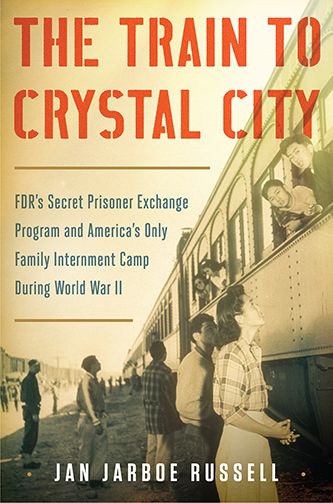2016
The Train to Crystal City by Jan Jarboe Russell
 The dramatic and never-before-told story of a secret FDR approved American internment camp in Texas during World War II, where thousands of families -- many US citizens -- were incarcerated.
The dramatic and never-before-told story of a secret FDR approved American internment camp in Texas during World War II, where thousands of families -- many US citizens -- were incarcerated.
During World War II, trains delivered thousands of civilians from the United States and Latin America to Crystal City, Texas, a small desert town at the southern tip of Texas. The trains carried Japanese, German, Italian immigrants and their American-born children. The only family internment camp during World War II, Crystal City was the center of a government prisoner exchange program called "quiet passage." During the course of the war, hundreds of prisoners in Crystal City, including their American-born children, were exchanged for other more important Americans -- diplomats, businessmen, soldiers, physicians, and missionaries -- behind enemy lines in Japan and Germany.
Focusing her story on two American-born teenage girls who were interned, author Jan Jarboe Russell uncovers the details of their years spent in the camp; the struggles of their fathers; their families' subsequent journeys to war-devastated Germany and Japan; and their years-long attempt to survive and return to the United States, transformed from incarcerated enemies to American loyalists. Their stories of day-to-day life at the camp, from the ten-foot high security fence to the armed guards, daily roll call, and censored mail, have never been told.
Combining big-picture World War II history with a little-known event in American history that has long been kept quiet, The Train to Crystal City reveals the war-time hysteria against the Japanese and Germans in America, the secrets of FDR's tactics to rescue high-profile POWs in Germany and Japan, and how the definition of American citizenship changed under the pressure of war.
 Jan Jarboe Russell is the author of the New York Times bestseller, The Train to Crystal City. The book exposes the little-known story of a family internment camp in World War II located in Crystal City, Texas that housed Japanese, German and Italian immigrants and their American-born children. The camp in Crystal City became the center of President Roosevelt’s prisoner exchange program. In 2016, The Train To Crystal City won the Carr P. Collins Award for Best Book of Nonfiction, given by the Texas Institute of Letters.
Jan Jarboe Russell is the author of the New York Times bestseller, The Train to Crystal City. The book exposes the little-known story of a family internment camp in World War II located in Crystal City, Texas that housed Japanese, German and Italian immigrants and their American-born children. The camp in Crystal City became the center of President Roosevelt’s prisoner exchange program. In 2016, The Train To Crystal City won the Carr P. Collins Award for Best Book of Nonfiction, given by the Texas Institute of Letters.
Russell was born in Beaumont, Texas. She graduated from the University of Texas at Austin in 1972 and became a political reporter for The San Antonio Light. In 1976, she joined the Hearst Bureau in Washington, D.C. She later went to work as a columnist for the San Antonio Express-News.
In 1984 she was named a Nieman Fellow at Harvard, one of twelve American journalists to study at Harvard that academic year. Upon her return home to Texas, she shifted her career to long-form journalism and joined Texas Monthly magazine as a senior editor. In 1989, her story, “Adoption: The Woes of Wednesday Child” She is currently a contributing editor to Texas Monthly.
In 1999, Scribner’s published her well-received biography of Lady Bird Johnson, named by The Washington Post one of the best books of the year. She also compiled and edited They Lived To Tell The Tale, published under the Explorer’s Club imprint.
Jan lives in San Antonio with her husband, Dr. Lewis F. Russell, Jr. They have four children.
Photo by Trish Simonite
| Location | Date | Time | |
|---|---|---|---|
| Wharton County Library | October 4 | 6:00 PM | |
| Holocaust Museum Houston | October 5 | 6:30 PM | RSVP Here |
| Asia Society Texas Center | October 16 | 3:00 PM | RSVP Here |
| Lone Star College North Harris | October 17 | 12:30 PM | |
| Harris County Law Library | October 18 | 1:00 PM | Register Here |
| Cypress Creek Community Center | October 18 | 6:30 PM | |
| Lamar University, Mary and John Gray Library | October 19 | 1:00 PM | |
| Houston Community College | October 20 | 11:00 AM | Central, Learning Hub 100 |
| San Jacinto College Lee Davis Library | October 25 | 10:00 AM | |
| Texas Southern University Library | October 27 | 6:30 PM |
About the Book
|
History in Five: FDR’s Secret Enemy Exchange Program |
- Book Discussion Questions from Houston Great Books
- Photos of the Train to Crystal City
- "Jan Jarboe Russell Writes Book on Texas WWII Internment Camp" by Kathleen Petty, San Antonio Magazine
- "The American Internment Camp You Never Heard of" by Jan Jarboe Russell, History News Network
- "5 Surprises About America's Imprisoning People During World War II" by Jan Jarboe Russell, Business Insider
- "Purgatory at Home in Wartime" by Janet Maslin, The New York Times
- Book Q&As with Deborah Kalb
About the Crystal City Internment Camp
| A video made from a public domain film produced by the Immigration and Naturalizaton Service in 1945 of the family internment camp at Crystal City, Texas. This camps was used for the incarceration of German Americans, German Latin Americans, Italian Americans and Italian Latin Americans, as well as Japanese Americans and Japanese Latin Americans. |
| See how the dedication of an historic site has led to healing for hundreds of families that were once held at the Crystal City Family Internment Camp. |
- Crystal City (Family) Internment Camp - Texas Historical Commission
- Crystal City Family Internment Camp (PDF) - Texas Historical Commission
- Legacy of Heart Mountain - ABC News Documentary (Heart Mountain is mentioned several times in the book)
Nonfiction
By Order of the President : FDR and the Internment of Japanese Americans by Greg Robinson
On February 19, 1942, following the Japanese bombing of Pearl Harbor and Japanese successes in the Pacific, President Franklin Roosevelt signed Executive Order 9066, which allowed for the summary removal of Japanese aliens and American citizens of Japanese descent from their West Coast homes, and their incarceration under guard in camps. Amid the numerous histories of this shameful event, FDR's contributions have been seen as negligible. Now, using Roosevelt's own writings and other documents, historian Robinson reveals the president's central role in the internment and examines not only what the president did but why.
Citizen 13660 by Miné Okubo
Mine Okubo was one of over one hundred thousand people of Japanese descent - nearly two-thirds of whom were American citizens - who were forced into "protective custody" shortly after Pearl Harbor. Citizen 13660 , Okubo's graphic memoir of life in relocation centers in California and Utah, illuminates this experience with poignant illustrations and witty, candid text.
Farewell to Manzanar by Jeanne Wakatsuki Houston and James D. Houston
Jeanne Wakatsuki was seven years old in 1942 when her family was uprooted from their home and sent to live at Manzanar internment camp with 10,000 other Japanese Americans. Along with searchlight towers and armed guards, Manzanar ludicrously featured cheerleaders, Boy Scouts, sock hops, baton twirling lessons and a dance band called the Jive Bombers who would play any popular song except the nation's #1 hit: "Don't Fence Me In."
Colors of Confinement: Rare Kodachrome Photographs of Japanese American Incarceration in World War II edited by Eric L. Muller; with photographs by Bill Manbo.
In 1942, Bill Manbo (1908-1992) and his family were forced from their Hollywood home into the Japanese American internment camp at Heart Mountain in Wyoming. While there, Manbo documented both the bleakness and beauty of his surroundings, using Kodachrome film, a technology then just seven years old, to capture community celebrations and to record his family's struggle to maintain a normal life under the harsh conditions of racial imprisonment.
The Zookeeper's Wife by Diane Ackerman
The true story of how the keepers of the Warsaw Zoo saved hundreds of people from Nazi hands. When Germany invaded Poland, Stuka bombers devastated Warsaw--and the city's zoo along with it. With most of their animals dead, zookeepers Jan and Antonina Żabiński began smuggling Jews into empty cages. Another dozen "guests" hid inside the Żabińskis' villa, emerging after dark for dinner, socializing, and, during rare moments of calm, piano concerts.
Freedom from Fear : the American People in Depression and War, 1929-1945 by David M. Kennedy
Between 1929 and 1945, two great travails were visited upon the American people: the Great Depression and World War II. Freedom from Fear tells the story of how Americans endured, and eventually prevailed, in the face of those unprecedented calamities.
Fiction
When the Emperor was Divine: a Novel by Julie Otsuka
Otsuka's commanding debut novel paints a portrait of the Japanese internment camps unlike any previously written--a haunting evocation of a family in wartime and an unmistakably resonant lesson for our times. On a sunny day in Berkeley, California, in 1942, a woman sees a sign in a post office window, returns to her home, and matter-of-factly begins to pack her family's possessions. Like thousands of other Japanese Americans they have been reclassified, virtually overnight, as enemy aliens and are about to be uprooted from their home and sent to a dusty internment camp in the Utah desert.
The Translation of Love by Lynne Kutsukake
An emotionally gripping portrait of post-war Japan, where a newly repatriated girl must help a classmate find her missing sister. After spending the war years in a Canadian internment camp, thirteen-year-old Aya Shimamura and her father are faced with a gut-wrenching choice: Move east of the Rocky Mountains or go "back" to Japan . Barred from returning home to the west coast and bitterly grieving the loss of Aya's mother during internment, Aya's father signs a form that enables the government to deport them.
Allegiance by Kermit Roosevelt
A sophisticated legal thriller that plunges readers into the debate within the US government surrounding the imprisonment of thousands of Japanese-Americans during World War II.
When the news broke about the Japanese attack on Pearl Harbor, Caswell "Cash" Harrison was all set to drop out of law school and join the army... until he flunked the physical. Instead, he's given the opportunity to serve as a clerk to Supreme Court Justice Hugo Black. He and another clerk stumble onto a potentially huge conspiracy aimed at guiding the court's interests, and the cases dealing with the constitutionality of the prison camps created to detain Japanese-Americans seem to play a key part.
No-No Boy by John Okada
First published in 1956, No-No Boy was virtually ignored by a public eager to put World War II and the Japanese internment behind them. It was not until the mid-1970s that a new generation of Japanese American writers and scholars recognized the novel's importance and popularized it as one of literature's most powerful testaments to the Asian American experience. No-No Boy tells the story of Ichiro Yamada, a fictional version of the real-life "no-no boys." Yamada answered "no" twice in a compulsory government questionnaire as to whether he would serve in the armed forces and swear loyalty to the United States. Unwilling to pledge himself to the country that interned him and his family, Ichiro earns two years in prison and the hostility of his family and community when he returns home to Seattle.
Hotel on the Corner of Bitter and Sweet by Jamie Ford
When artifacts from Japanese families sent to internment camps during World War II are uncovered during renovations at a Seattle hotel, Henry Lee embarks on a quest that leads to memories of growing up Chinese in a city rife with anti-Japanese sentiment. Most of all, he remembers a young Japanese American girl from his childhood in the 1940s--Keiko Okabe, with whom he forged a bond of friendship and innocent love that transcended the prejudices of their Old World ancestors.
Books for Youth
Baseball Saved Us by Ken Mochizuki; illustrated by Dom Lee
A Japanese American boy learns to play baseball when he and his family are forced to live in an internment camp during World War II, and his ability to play helps him after the war is over.
Dear Miss Breed : True Stories of the Japanese American Incarceration During World War II and a Librarian Who Made a Difference by Joanne Oppenheim
In the early 1940's, Clara Breed was the children's librarian at the San Diego Public Library. But she was also friend to dozens of Japanese American children and teens when war broke out in December of 1941. The story of what happened to these American citizens is movingly told through letters that her young friends wrote to Miss Breed during their internment.
Fish for Jimmy : Inspired by One Family's Experience in a Japanese American Internment Camp by Katie Yamasaki.
When brothers Taro and Jimmy and their mother are forced to move from their home in California to a Japanese internment camp in the wake of the 1941 Pearl Harbor bombing, Taro daringly escapes the camp to find fresh fish for his grieving brother.
Echo : a Novel by Pam Muñoz Ryan
Lost in the Black Forest, Otto meets three mysterious sisters and finds himself entwined in a puzzling quest involving a prophecy, a promise, and a harmonica. Decades later, as the second World War approaches, the lives of three children -- Friedrich in Germany, Mike in Pennsylvania, and Ivy in California -- become interwoven when the very same harmonica lands in their lives. All the children face daunting challenges: rescuing a father, protecting a brother, holding a family together. Pulled by the invisible thread of destiny, their solo stories converge.
Weedflower by Cynthia Kadohata
After twelve-year-old Sumiko and her Japanese-American family are relocated from their flower farm in southern California to an internment camp on a Mojave Indian reservation in Arizona, she helps her family and neighbors, becomes friends with a local Indian boy, and tries to hold on to her dream of owning a flower shop.
Between Shades of Gray by Ruta Sepetys
In 1941, fifteen-year-old Lina, her mother, and brother are pulled from their Lithuanian home by Soviet guards and sent to Siberia, where her father is sentenced to death in a prison camp while she fights for her life, vowing to honor her family and the thousands like hers by burying her story in a jar on Lithuanian soil.
The Journal of Ben Uchida, Citizen #13559, Mirror Lake Internment Camp by Barry Denenberg
Twelve-year-old Ben Uchida keeps a journal of his experiences as a prisoner in a Japanese internment camp in Mirror Lake, California, during World War II.







